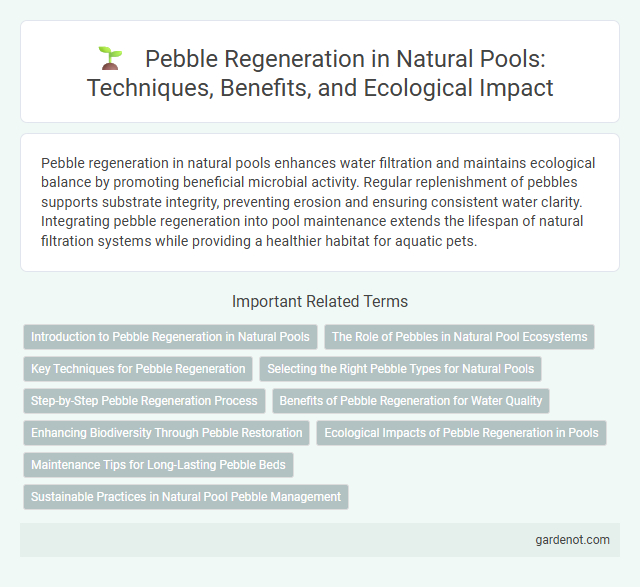Pebble regeneration in natural pools enhances water filtration and maintains ecological balance by promoting beneficial microbial activity. Regular replenishment of pebbles supports substrate integrity, preventing erosion and ensuring consistent water clarity. Integrating pebble regeneration into pool maintenance extends the lifespan of natural filtration systems while providing a healthier habitat for aquatic pets.
Introduction to Pebble Regeneration in Natural Pools
Pebble regeneration in natural pools involves the restoration and replenishment of pebble substrates to maintain water quality and habitat stability. Over time, pebbles can become compacted or covered with organic matter, reducing natural filtration and aesthetic appeal. Regular pebble regeneration supports effective biofiltration, promotes beneficial microorganism growth, and ensures the ecological balance of the natural pool environment.
The Role of Pebbles in Natural Pool Ecosystems
Pebbles in natural pool ecosystems serve as crucial substrates that enhance water filtration and provide habitats for beneficial microorganisms and aquatic plants. Their porous surfaces promote biofilm growth, which plays a vital role in nutrient cycling and maintaining water clarity. By supporting diverse microbial communities, pebbles contribute to the self-sustaining purification processes essential for balanced natural pool environments.
Key Techniques for Pebble Regeneration
Key techniques for pebble regeneration in natural pools include thorough cleaning using high-pressure water jets to remove algae, biofilm, and sediment build-up. Mechanical agitation combined with manual sorting helps separate reusable pebbles from damaged or eroded ones, ensuring structural integrity and aesthetic quality. Regular application of eco-friendly mineral treatments enhances pebble durability and reduces organic growth, maintaining a pristine pool environment.
Selecting the Right Pebble Types for Natural Pools
Selecting the right pebble types for natural pools is crucial for maintaining water clarity and supporting beneficial microbial ecosystems. Smooth, rounded river pebbles with varying sizes enhance filtration by creating optimal spaces for biofilm development, which naturally breaks down impurities. Using durable, non-porous stones like quartz or granite pebbles ensures longevity and reduces sediment buildup, promoting a healthy aquatic environment.
Step-by-Step Pebble Regeneration Process
Pebble regeneration in natural pools involves a systematic process beginning with draining the pool to expose the pebble surface completely. The next step includes thorough cleaning using specialized brushes and eco-friendly detergents to remove algae, dirt, and mineral buildup without harming the surrounding ecosystem. Finally, inspecting and replacing damaged pebbles ensures optimal water filtration and maintains the pool's natural aesthetic and ecological balance.
Benefits of Pebble Regeneration for Water Quality
Pebble regeneration in natural pools enhances water quality by improving filtration and reducing impurities through increased surface area for beneficial bacteria colonization. This biological filtration breaks down organic matter effectively, leading to clearer and healthier water conditions. Regular pebble regeneration also prevents clogging and maintains optimal water circulation, supporting balanced aquatic ecosystems.
Enhancing Biodiversity Through Pebble Restoration
Pebble regeneration in natural pools plays a crucial role in enhancing biodiversity by providing essential habitats for various aquatic organisms such as insects, amphibians, and microorganisms. Restored pebble substrates improve water filtration and oxygenation, creating optimal conditions for native plant growth and supporting diverse ecological communities. Effective pebble restoration promotes ecosystem resilience and sustains the natural balance within the aquatic environment.
Ecological Impacts of Pebble Regeneration in Pools
Pebble regeneration in natural pools enhances water filtration by promoting beneficial microbial activity, which helps reduce nutrient buildup and inhibits algae growth. The process supports aquatic biodiversity by providing habitat for microorganisms and small invertebrates essential to the ecosystem's balance. Using eco-friendly materials for pebble replacement minimizes disruption to local flora and fauna, ensuring sustainable pool maintenance aligned with natural environmental cycles.
Maintenance Tips for Long-Lasting Pebble Beds
Regular brushing of pebble beds prevents algae buildup and maintains water clarity in natural pools. Periodic inspection for signs of wear or displacement ensures the pebbles remain properly aligned and secure. Using a gentle water jet or low-pressure washing helps remove debris without disturbing the pebble structure, prolonging the bed's durability.
Sustainable Practices in Natural Pool Pebble Management
Pebble regeneration in natural pools relies on sustainable practices such as using locally sourced materials and implementing natural filtration systems that reduce chemical use and erosion. Regular monitoring of pebble condition and organic matter accumulation helps maintain ecological balance and water clarity. Employing biodegradable cleaning methods and minimizing disturbances to native aquatic life supports long-term pebble preservation and overall pool health.
Pebble regeneration Infographic

 gardenot.com
gardenot.com